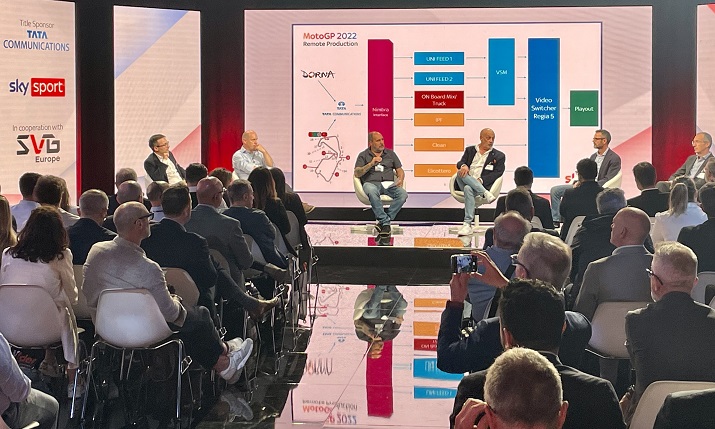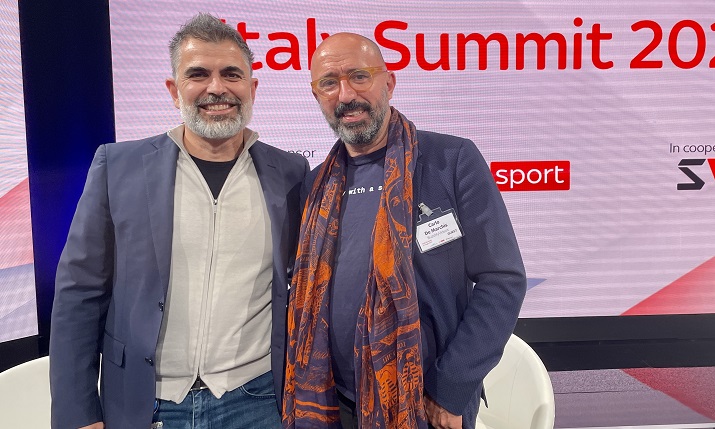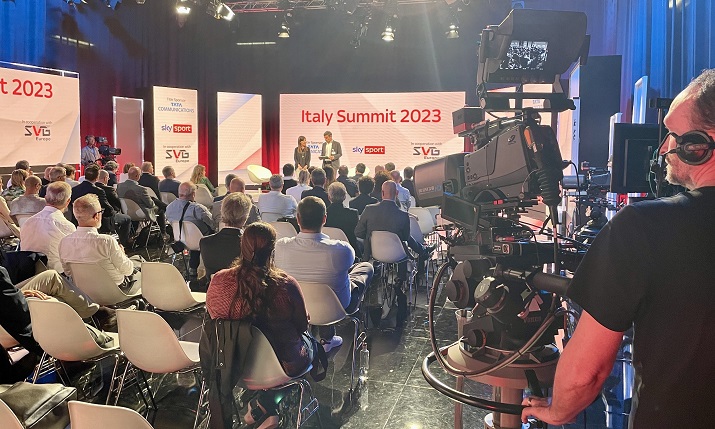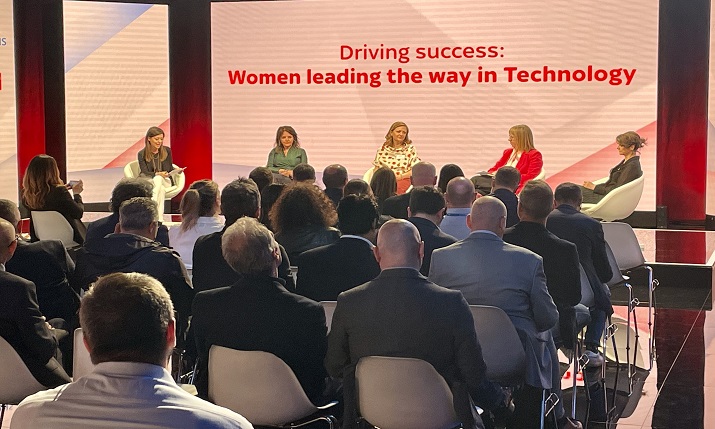Italy Summit 2023: remote production, AI & advances in storytelling and women in tech

Rossella de Vivo, Sky Italia and Dante De Iulio, Sky Italia, welcoming attendees to the Italy Summit 2023
After a long break due to the pandemic, the Italy Summit returned to Milan at the end of May. Organised by Sky Sport in collaboration with SVG Europe, the event was attended by a capacity crowd – a sign of great interest in sport, broadcasting, new forms of content creation and distribution and the specialised industry that gravitates around it. And, with all discussions in Italian, it provided a great opportunity for the local production and technology community to gather and discuss the latest trends and innovation.
Beyond the Screen: Revealing Serie B remote production
The first panel addressed one of the most interesting topics of the moment; remote production, and in particular how Italy’s Serie B soccer took on the challenge of producing matches remotely in order to add more value and get closer to what is produced in Serie A.
The long journey involved 390 matches with moments of innovation in 4K HDR and involved, in the first phase, the use of drones, corner cams and other “small” technical innovations. The second phase – that of the present – is linked to the desire to go further.
NVP chief technology officer Ivan Pintabona explained how his production company, in partnership with Sky and Lega Serie B, addressed workflow, image quality and bandwidth, and he spoke about the challenges they have overcome, which ones to tackle next, and how AI, the second driving theme of the day, can enter the workflow.

Left to right: Dante De Iulio, Sky Italia (moderator), Ivan Pintabona, NVP, Fabio Ghezzi, Lega Serie B, Ferruccio Zanotti, Sky Italia
Pintabona said: “We have entered into a defined project, with a cautious workflow that does not have too much impact on an agnostic model, which can be interfaced with any existing infrastructure”.
According to the typical model based on network management, the cameras and the provision for disaster recovery are in place, while the editorial aspects are managed in the production hub of Cologno Monzese.
He explained: “The main difficulties were in the management of connectivity and available bandwidth, which can be considered as average – but increasing – connection levels. We started from the availability of around 1Gb/sec to be divided with the other services for an average availability on each stage of around 300MB”.
NVP has employed an innovative technology, based on particular predictive compression algorithms that also exploit AI, which has made it possible to obtain manageable latency and a quality product.
Among the many topics addressed by Pintabona, were the various ways of applying full remote production, the potential, and the workflow.
Head of audiovisual and TV production at Lega Serie B Fabio Ghezzi confirmed that the shift to remote production by Lega Serie B was a technological and editorial step forward, with potential benefits for end users.
“The results were extraordinary,” he said. “Content produced and broadcast in UHD HDR is unique in Italy, and technological innovation has a value in itself; there is no appreciable visual difference between traditional production and today’s remote production”.
He then spoke of advantages of remote production compared to the use of traditional resources, such as less pollution, reduced movement of vehicles and greater utilisation of equipment.
“We can make content that doesn’t exist today,” he concluded, “that’s great for monetisation and that will give new energy to produce other content. Today there is a way to watch the match, and in a very short time there will be many”.
Ferruccio Zanotti, Sky Sport Football senior producer said that after 20 years of in-person TV productions in the field he feared having to work in a “confused environment”, but from the first remote production it was an identical situation to working in a stadium.
Italy Summit 2023 Watch videos of all the sessions here
The differences could be expressed as opportunities: fewer vehicles travelling, an eye to sustainability, and greater ability to manage complicated situations and in particular logistics.
These months of testing indicate that Sky will soon be fully operational with remote production, where they will be able to produce many more matches.
“Yes, remote production is ready to make a big leap, we’ll just have to create a workflow ad doc for each discipline; for example, the Champions League has one, Serie A another. We just need a mindset change.”
Powering Up Remote Production: MotoGP case study
In the second panel, Sky Sport’s Stefano Valsecchi introduced Andrea Picchioni, technical operation supervisor, Sky Sport who described the MotoGP remote production setup.
He said: “It is designed to be modular and customisable according to the project, both in the European and non-European locations and in different production situations with a pre-race, a race with an interactive channel, and post-race content.”
The director at Sky’s facility in the Santa Giulia district of Milan can receive practically all the signals, packaged by ultra-low latency encoders and decoders arriving from the venues and decide – via remote-controlled matrix and on-site panels – which ones to switch, and also manage other multicasting signals arriving from the Dorna headquarters in Barcelona.

Stefano Valsecchi, Sky Italia (moderator), Andrea Gianolli, ONE TV, Andrea Picchioni, Sky Sport, Giovanni Pippia, Dorna Sports, Michele Fornasiero, Sky Italia
This has greatly reduced bandwidth consumption from the venue and from Dorna’s headquarters.
“This has changed a lot”, Picchioni concluded. “The widespread concept is that for remote production it is essential to transport all feeds from the venue to the production centre, with consequent significant bandwidth consumption”.
Full remote production
The chief executive of ONE TV, Andrea Gianolli, underlined that full remote production is a project born to give an answer to various production situations, such as coding and transport streaming, but also integration of resources, respecting precise dictates such as the containment of bandwidth consumption, the security of the connection and the total latency of the “round trip” of less than a second.
By means of an interface between the gallery in Santa Giulia and the one on location, a dynamic tie-line system interprets the director’s request and intelligently routes the signals.
Today, all 120 signals available in the venue are switchable in the control room, without limitations. “Proprietary codecs and transport streams”, he said, “are the result of our merger of various systems of which we have used different libraries, making a mix of various opportunities”.
Sky Italia head of studios Michele Fornasiero added: “The initial and main objective was to make MotoGP production more sustainable today; in addition to continuing the process of technological innovation begun by our colleagues in news, we have managed, above all, to increase the customer experience for customers, through a very dynamic story”.
Giovanni Pippia, media facilities senior director, Dorna Sports, went on to describe how the other six broadcasters abroad involved in MotoGP handle remote production, according to their different philosophies and cultures.
Exploring the Future: an insightful conversation on the Future of Sport technologies and Generative AI
This discussion conducted by Riccardo Botta, group director content experience and distribution operations of Sky, with Carlo De Marchis, founder, FACTORY63 and strategic advisor, Cleng and BuzzMyVideos and known for thirty years as an evangelist also in sports broadcast, explored new technologies and their likely impact on sports production and broadcasting.

Riccardo Botta with Carlo De Marchis
“Cross-contamination between pure sport and entertainment is a necessity to reach a wider audience today. This is a breakthrough,” said De Marchis.
His in-depth analysis indicated seven trends in general: the Importance of Sports Rights, the Disruptive Influence of Streaming, the Strategy of DAZN, the Involvement of Big Tech, the growing importance of “original storytelling”, the new AVOD channels and FAST and the PayTV Counteroffensive.
He then pointed to some examples of interesting use of “innovation” with an international slant, citing Kings League, Wrexham FC, women’s sports, Apple’s MLS deal, and esports.
For the topic of great interest, AI, he analysed the impact on the world of content creation and distribution in sports and media in general, trying to grasp the various ways in which generative AI could change things for end users as well as creators, media groups and vendors.
One example was a system that, starting from highlights and match data, recreates audio commentary with the voice of a well-known English commentator and automatically creates the text at the right moment in the video.
“Everything is very rudimentary” concluded De Marchis, “but it can speed up the creation of content in the hands of experts. In my opinion, now is the time to study and better understand what this type of AI can and cannot give, also considering risks and distortions”.
The transition to the cloud
One part of the discussion asked the participants to express their point of view on the availability or otherwise of cloud production.
Giovanni Pippia of Dorna replied that “We are already partly in the cloud, we believe in it 100% and we will outsource it when we can manage all the signals we need. Today we are working hard in this direction with TATA Communication, our main partner, together with Grass Valley”.
Andrea Gianolli, ONE TV, said that: “Yes, the cloud is the future, but it doesn’t exist today. The problem that is holding back this type of development is that the engine system currently in the cloud still does not have sufficient reliability to be able to count on total processing in the cloud. It is a question of safety, as well as opportunity.
“Certain processes of the audio-video signals and communications will be all in the cloud or in a mixed configuration, but not today, because today it is not yet so reliable to guarantee the final product: there are still risks that must be taken”.
Ivan Pintabona, NVP, concluded by saying: “We tested a workflow with cloud technologies with excellent results and with 14 signals, but a step in this direction is needed by the workers, also for a change of mentality”.
Blending Creativity and Innovation: The Intersection of technology and Storytelling
Omar Schillaci, deputy director Sky TG24, Sky Italia introduced another panel on the intersections between technology and the possibility of creating newer, more immersive and participatory stories.
Also underlining the need to adapt to the habits of the viewer, Vincenzo Lagattolla, head of Creative Hub, Sky Italia, stated: “These are technologies available to everyone, the production of content by the user and virtual reality will help surpass previous standards and will support us in seeking a new language fueled by new technologies”.
“Virtual reality allows today, with tools that derive from video games, to change storytelling. We (broadcasters) have a responsibility to maintain a high standard, other than user-generated content. AI in particular can give us the opportunity to simplify and speed up editorial and production processes”.
Massimo Bertolotti, communication and infrastructure senior director, Sky Italia, underlined some problems, such as the processing of personal data, the need for a certain regulation of AI, and the difficulties of containing such a “revolution”, especially in the “fake news” era.

Italy Summit 2023 took place at Sky’s facility in the Santa Giulia district of Milan
“Everything is connected,” he said, “we are instantaneous about everything. Making the most available information will help us better focus on what to ask. I see two problems: the energy costs of the computational capacity are not trivial, and the final output of this information, which brings together data that already exists and is not always free from copyright.
“If we remove the wrong element from the source, we can use generative AI to guide us and to complete our activity; otherwise, it is a solution that creates problems”.
Marco di Concetto, head of TV production systems technologies, Mediaset, added: “Technology comes to meet us with ecosystems that allow us to create content of excellent quality at the last moment and even in extreme conditions”.
For example, 5G, even with network slicing technologies, makes it possible to produce extremely dignified 4:2:2 10-bit television-quality video.
AI helps a lot to create increasingly realistic “things, he said. “From a story and a single outlet,” he concluded, “we can go to a story on multiple outlets. AI aggregates the most disparate videos, helps the journalist and also makes it possible to adapt – more or less automatically – the narrative content and distribute it on various different outlets, the web, social networks, radio, and so on. Technologies are evolving towards systems focused on the creation of the story”.
Claudia Severino, director In-Partnership/All News Productions, Mediaset, is a specialist in technological innovation. She spoke about how technology impacts storytelling. With example footage, she indicated a focus on two directions: technology has made storytelling more immersive and more widespread. Furthermore, storytelling has become more vital and engaging through virtual content.
“It is an important change”, she concluded, “which has cleared the “imperfection” in favour of the content itself and has freed creativity”.
Driving Success: Women Leading the way in Technology
Rossella de Vivo, Production & Creative Hub director, Sky Italia, moderated a panel on women in technology. One of the panelists, Scilla Signa, chief executive of Bridge the Gaps & Founder, Hackher, identified the stereotypes that could inhibit the female world versus adopting a career in technology areas.
The answer was that high school girls in some of the major Italian cities are totally unaware of what the world of technology is like, mirroring the world of school which lacks role models.

Rossella de Vivo, Sky Italia (moderator), Gabriella Vacca, Sky Italia, Mara Tanelli, Politecnico di Milano, Scilla Signa, Bridge the Gaps & Hackher_, Ilaria Cortese, Sky Italia
Rossella De Vivo then asked Mara Tanelli, professor of Automatic Control, Politecnico di Milano what the aspirations of women in the university world are and what the Politecnico puts in place to support their path also in today’s working world.
The answer was that “gender-driven” cultural stereotypes still guide the choice with some faculties, which are almost exclusively male, as well as certain professions.
So we try to work on the theme of the female engineering narrative and the transversality of women in the world of technology, trying to bring out the validity of female roles, celebrating them in the media and creating mentoring programmes at companies.
Ilaria Cortese, talent, development and diversity and inclusion director, Sky Italia, spoke about the inclusion of women in the company, the aspirations and fears that are seen, and how to encourage them in their professional growth.
She underlined the challenge that reflects the lack of self-awareness reflected in the figures which indicate that although the personnel entering are 50% female, only 25% continue to grow.
“Motivation to power is not power itself,” she said, “and in practice, a man’s career play pattern is still very different from that of a woman, who doesn’t know how strong her power to change the world is even if only by climbing one step further”.
Sky has implemented specific self-awareness strategies and the use of networking for a mentoring programme to address this.
Finally, Gabriella Vacca, CTO, Sky Italia & group director of enterprise technology solutions closed the panel by explaining that the guiding mindset in a successful path in various international contexts was “problem-solving”, starting from one’s personal experience and then arriving at that of the company.
“To overcome the gender gap” she concluded, “an even greater sensitivity of everyone is needed and determination is needed on the part of the individual”.
To Rossella De Vivo’s final summary question on “what characteristics should a woman show off to make a career in today’s technological world”, Vacca’s answers were: passion, determination, self-awareness, self-vision, along with a little lightness and indifference.

